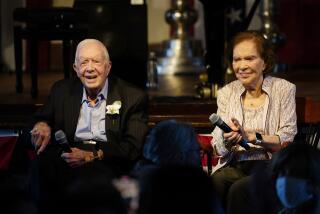Doctors Are Remiss at the Deathbed
- Share via
Every time Jack Kevorkian “assists” in the suicide of another patient, the media and the public ask the question: Should we or should we not legalize physician-assisted suicide? Now the Supreme Court is planning to issue an answer, but the primary question in this matter has not been asked: Why do American doctors allow people to suffer so ?
Why do physicians abandon patients when they are at the end of life or when they suffer from serious chronic illness? Why do they consistently fail to use the many drugs and techniques available to treat the excruciating pain, exhausting symptoms and mind-numbing depression that rob such patients of any peace and turn their care into a crushing burden for their friends and loved ones?
In many other industrialized nations, there is a well-developed approach to the care of the terminally ill and of patients whose chronic illnesses will eventually kill them. Physicians, nurses, social workers and other professional caregivers and volunteers work together to make sure that patients and families are able to live their lives to the fullest in spite of disease and disability. They specialize in a field that is called palliative care and it is available not only through hospice services delivered in the home but also in residential hospices and hospital units in major medical and cancer centers.
In the United States, palliative care and hospice pioneers have demonstrated that there is more to medicine than curing disease and defeating death. But their work is one of the best-kept secrets in America. That’s because, when it comes to the care of the chronically and terminally ill, most physicians in this country are as ignorant as their patients. According to a 1992-93 survey conducted by the American Medical Assn., of the nation’s 126 medical schools, only five have a required course on the care of the dying.
The Cecil Textbook of Medicine, a volume used by most medical students, devotes only three of its 2,300 pages to the care of the terminally ill. Another classic, Harrison’s Principles of Internal Medicine, states bluntly, “The discovery and cure of potentially serious disease represents a far greater service to one’s patients than ministrations in the course of an incurable condition.”
Only 17% of the nation’s 1,168 accredited medical residency programs offer training in hospices; less than 9% of these rotations are required. Studies show that residents aren’t rewarded for showing concern about the physical and emotional suffering of patients with incurable illnesses and are not taught the basics of palliative care.
It’s hardly surprising that those doctors who finally refer a few of their patients to hospice programs do so far too late in the dying process. At the Hospice of Galveston County in Texas, 40% of the adult patients die within five days of their admission.
Americans are becoming more aware of the medical profession’s failure to care for patients with incurable illness. But most members of the public receive their information about health care from the media. Reporters who so eagerly write about Kevorkian’s latest assisted suicide show almost no interest in hospice and palliative care. The media, like the medical community, seem to regard the field as mere handholding. Thus innovations and research into new ways of helping control patients’ pain, new treatments for debilitating symptoms like weight loss, fatigue and depression, and new ways to help family members shoulder their care-giving burden and cope with grief and loss go unreported. No wonder desperate patients think suicide is their only option.
But consider what would have happened if Kevorkian’s victims had known about the help they could have received in palliative care programs like the one run by Dr. Declan Walsh at the Cleveland Clinic Foundation in Ohio, or Dr. Carlos Gomez at the University of Virginia Health Sciences Center. Whether they were cared for in an outpatient clinic, in the hospital in specially designed units or with hospice services in the home, a team of doctors, nurses, social workers, pastoral counselors, music therapists and others could have helped them cope with their physical pain and emotional suffering. These caregivers could have followed them as their diseases progressed over months or even years and helped care for them at home or in the hospital when they died. Moreover, their families would also have been supported even months after their deaths.
Today, patients are showing their dissatisfaction with the medical system by demanding that their physicians kill them. What they should be demanding is that their physicians care for them--that medical schools teach physicians how to do this, that hospitals open up palliative care services and that insurers pay for this kind of care. Only when this happens will patients understand that suicide, physician-assisted or otherwise, is not the best way to make one’s final exit.
More to Read
Sign up for Essential California
The most important California stories and recommendations in your inbox every morning.
You may occasionally receive promotional content from the Los Angeles Times.













